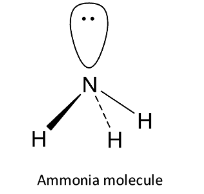Answer
39k+ views
Hint: Ammonia is a volatile trihydride of the element nitrogen of group 15. It has the formula \[{\text{N}}{{\text{H}}_{\text{3}}}\] . Nucleophiles or nucleophilic reagents are attracted to the nucleus or are nucleus loving or positive charge loving. Thus, the nucleophiles can be said to be the type of reagent species which are rich in electrons. Thus, the nucleophiles are negatively charged species.
Nucleophiles are of two types, negative nucleophiles or neutral nucleophiles. According to the Lewis concept, a nucleophile can donate an electron pair and hence it acts as a Lewis base.
Complete step by step answer:
The negative nucleophiles are those nucleophiles which have an excess electron pair and carry a negative charge. For example, carbanions have an unshared electron pair and a negative charge and hence they are negative nucleophiles. Another example of negative nucleophile is the bromide ion.
The neutral nucleophiles are those nucleophiles which have an unshared pair of electrons but do not carry any charge. Now, let us see the structure of the ammonia molecule. The valence shell configuration of nitrogen is ${\text{2}}{{\text{s}}^{\text{2}}}{\text{2}}{{\text{p}}^{\text{3}}}$ and it undergoes ${\text{s}}{{\text{p}}^{\text{3}}}$ hybridization. Three of the four ${\text{s}}{{\text{p}}^{\text{3}}}$ hybrid orbitals overlap with 1s orbitals of 3 hydrogen atoms to form 3 ${\text{N - H}}$ sigma bonds while the fourth contains the lone pair of electrons. It has pyramidal structure.

Thus ammonia contains a lone pair of electrons but has no charge. Hence, it is a neutral nucleophile. So, option A is correct.
An electron deficient molecule will try to take electrons from other sources and thus it is electron loving. Therefore, it will be an electrophile. So, option B is wrong.
A homolytic molecule undergoes homolytic fission to give free radicals. In homolytic bond fission, the shared pair of electrons is distributed equally between two bonded atoms. So, option C is wrong.
According to the Lewis concept, an electrophile accepts an electron pair and hence it acts as a Lewis acid and a nucleophile can donate an electron pair and hence it acts as a Lewis base. Thus ammonia is a base and not an acid.
So, option D is wrong.
Note: Another type of reagent is free radical. It is a neutral species carrying an unpaired electron and it is formed by the homolytic bond fission of a covalent bond. Due to the presence of unpaired electrons, free radicals are paramagnetic.

Nucleophiles are of two types, negative nucleophiles or neutral nucleophiles. According to the Lewis concept, a nucleophile can donate an electron pair and hence it acts as a Lewis base.
Complete step by step answer:
The negative nucleophiles are those nucleophiles which have an excess electron pair and carry a negative charge. For example, carbanions have an unshared electron pair and a negative charge and hence they are negative nucleophiles. Another example of negative nucleophile is the bromide ion.
The neutral nucleophiles are those nucleophiles which have an unshared pair of electrons but do not carry any charge. Now, let us see the structure of the ammonia molecule. The valence shell configuration of nitrogen is ${\text{2}}{{\text{s}}^{\text{2}}}{\text{2}}{{\text{p}}^{\text{3}}}$ and it undergoes ${\text{s}}{{\text{p}}^{\text{3}}}$ hybridization. Three of the four ${\text{s}}{{\text{p}}^{\text{3}}}$ hybrid orbitals overlap with 1s orbitals of 3 hydrogen atoms to form 3 ${\text{N - H}}$ sigma bonds while the fourth contains the lone pair of electrons. It has pyramidal structure.

Thus ammonia contains a lone pair of electrons but has no charge. Hence, it is a neutral nucleophile. So, option A is correct.
An electron deficient molecule will try to take electrons from other sources and thus it is electron loving. Therefore, it will be an electrophile. So, option B is wrong.
A homolytic molecule undergoes homolytic fission to give free radicals. In homolytic bond fission, the shared pair of electrons is distributed equally between two bonded atoms. So, option C is wrong.
According to the Lewis concept, an electrophile accepts an electron pair and hence it acts as a Lewis acid and a nucleophile can donate an electron pair and hence it acts as a Lewis base. Thus ammonia is a base and not an acid.
So, option D is wrong.
Note: Another type of reagent is free radical. It is a neutral species carrying an unpaired electron and it is formed by the homolytic bond fission of a covalent bond. Due to the presence of unpaired electrons, free radicals are paramagnetic.

Recently Updated Pages
silver wire has diameter 04mm and resistivity 16 times class 12 physics JEE_Main

A parallel plate capacitor has a capacitance C When class 12 physics JEE_Main

A series combination of n1 capacitors each of value class 12 physics JEE_Main

When propyne is treated with aqueous H2SO4 in presence class 12 chemistry JEE_Main

Which of the following is not true in the case of motion class 12 physics JEE_Main

The length of a potentiometer wire is 10m The distance class 12 physics JEE_MAIN

Other Pages
A closed organ pipe and an open organ pipe are tuned class 11 physics JEE_Main

A convex lens is dipped in a liquid whose refractive class 12 physics JEE_Main

Iodoform can be prepared from all except A Acetaldehyde class 12 chemistry JEE_Main

The resultant of vec A and vec B is perpendicular to class 11 physics JEE_Main

448 litres of methane at NTP corresponds to A 12times class 11 chemistry JEE_Main

Dissolving 120g of urea molwt60 in 1000g of water gave class 11 chemistry JEE_Main



